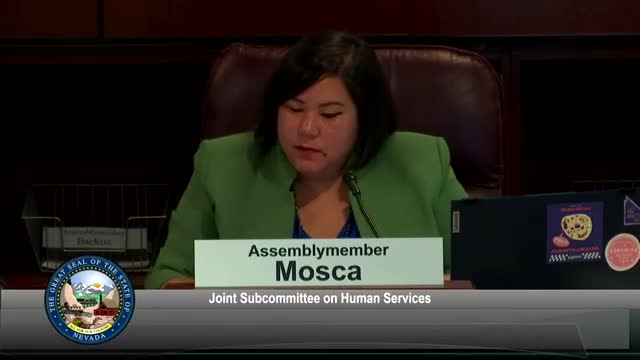Childcare subsidy caseload being reduced to match funding; division replaces vendor and issues new RFP
February 18, 2025 | 2025 Legislature NV, Nevada
This article was created by AI summarizing key points discussed. AI makes mistakes, so for full details and context, please refer to the video of the full meeting. Please report any errors so we can fix them. Report an error »

The Division of Welfare and Supportive Services told the joint subcommittee it is intentionally reducing the child‑care subsidy caseload to align with available funding and that it is replacing an underperforming vendor while issuing a new RFP for a long‑term eligibility and payment system.
Deputy Lisa Swearingen said the division expects to sustain about 7,500 children per month under the subsidy program, down from a current caseload of approximately 13,000. She said the decline is already happening at roughly 200 to 250 children per week as renewals and income‑limit adjustments proceed: “Right now, we are currently at a little over 13,000. We are seeing a reduction every week of about 200, 2 50 kids rolling off,” Swearingen said.
Swearingen described funding constraints: the childcare block grant was described as roughly $114 million, but only about 75% is permitted for direct subsidy; other required federal set‑asides (quality, admin) lower the sustainable subsidy level to roughly $96 million. The division said it is taking steps to reduce administrative costs by bringing eligibility processing in‑house and by replacing a failing vendor for the legacy NCCS system with Deloitte to stabilize operations while a new RFP moves forward.
IT costs and timeline: Lisa Swearingen and Lisa Swearingen’s IT colleague described aid‑code work and system changes. Lisa Swearingen (IT) told the committee that “1 aid code costs approximately $850,000 just just the coding itself,” and that broader system changes and vendor hourly rates contribute to a roughly $1 million one‑time vendor expense for creating an aid code and the reporting necessary to track opioid settlement aid codes and kinship expansions. The division estimated about 6–9 months to build new aid codes and roll out changes; for certain childcare system staffing the division asked that positions begin around October so staff can participate in requirements and implementation.
Communication and wait list: lawmakers pressed the division on how families and providers are notified; Swearingen said the division conducts webinars, provider calls, social media, and direct outreach and that staff are notifying parents and providers about changes. She also said the existing wait list has declined to about 1,832 families from an earlier (approximately) 2,400 figure.
No appropriation was adopted during the hearing; members requested follow‑up documentation on vendor arrangements, RFP timeline, outreach to families and caseload projections.
Deputy Lisa Swearingen said the division expects to sustain about 7,500 children per month under the subsidy program, down from a current caseload of approximately 13,000. She said the decline is already happening at roughly 200 to 250 children per week as renewals and income‑limit adjustments proceed: “Right now, we are currently at a little over 13,000. We are seeing a reduction every week of about 200, 2 50 kids rolling off,” Swearingen said.
Swearingen described funding constraints: the childcare block grant was described as roughly $114 million, but only about 75% is permitted for direct subsidy; other required federal set‑asides (quality, admin) lower the sustainable subsidy level to roughly $96 million. The division said it is taking steps to reduce administrative costs by bringing eligibility processing in‑house and by replacing a failing vendor for the legacy NCCS system with Deloitte to stabilize operations while a new RFP moves forward.
IT costs and timeline: Lisa Swearingen and Lisa Swearingen’s IT colleague described aid‑code work and system changes. Lisa Swearingen (IT) told the committee that “1 aid code costs approximately $850,000 just just the coding itself,” and that broader system changes and vendor hourly rates contribute to a roughly $1 million one‑time vendor expense for creating an aid code and the reporting necessary to track opioid settlement aid codes and kinship expansions. The division estimated about 6–9 months to build new aid codes and roll out changes; for certain childcare system staffing the division asked that positions begin around October so staff can participate in requirements and implementation.
Communication and wait list: lawmakers pressed the division on how families and providers are notified; Swearingen said the division conducts webinars, provider calls, social media, and direct outreach and that staff are notifying parents and providers about changes. She also said the existing wait list has declined to about 1,832 families from an earlier (approximately) 2,400 figure.
No appropriation was adopted during the hearing; members requested follow‑up documentation on vendor arrangements, RFP timeline, outreach to families and caseload projections.
View full meeting
This article is based on a recent meeting—watch the full video and explore the complete transcript for deeper insights into the discussion.
View full meeting